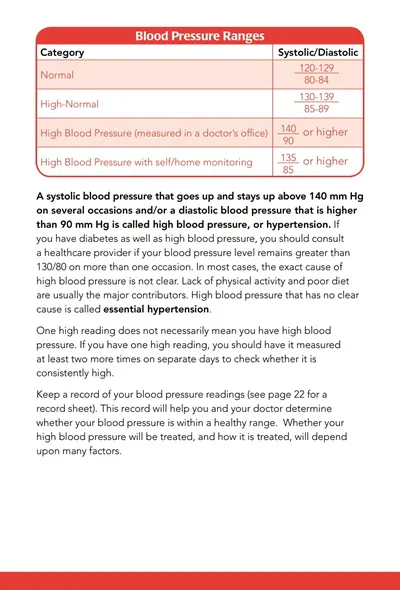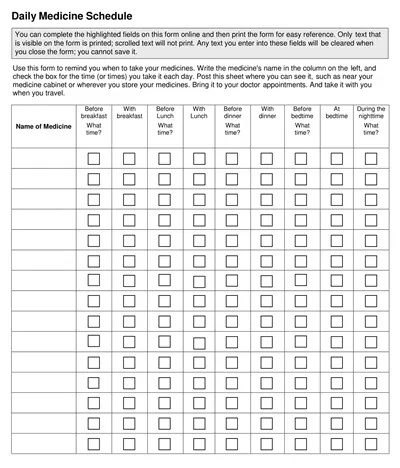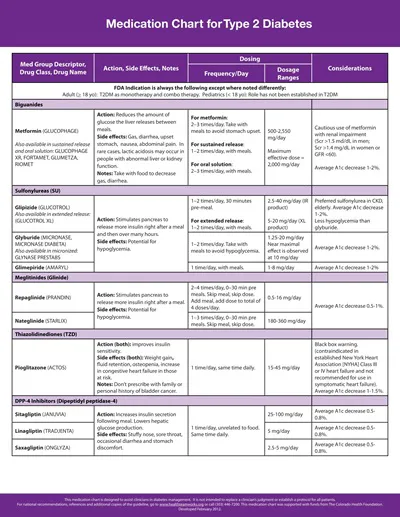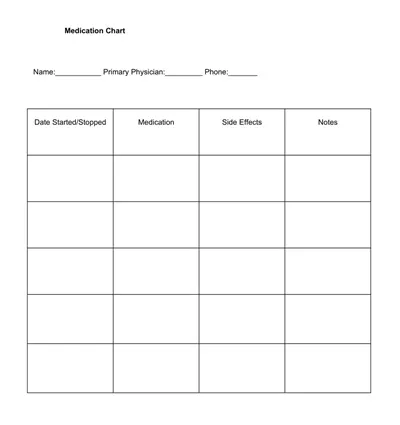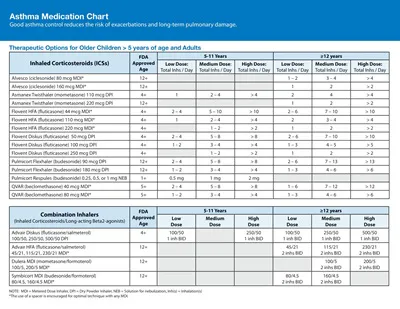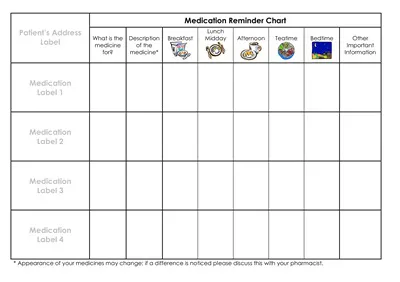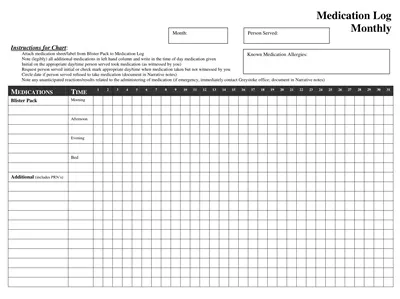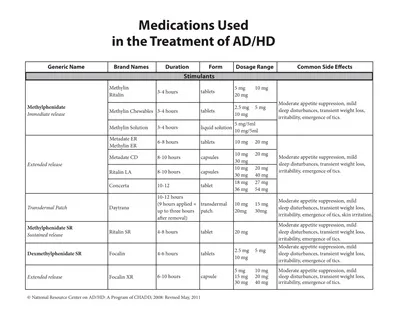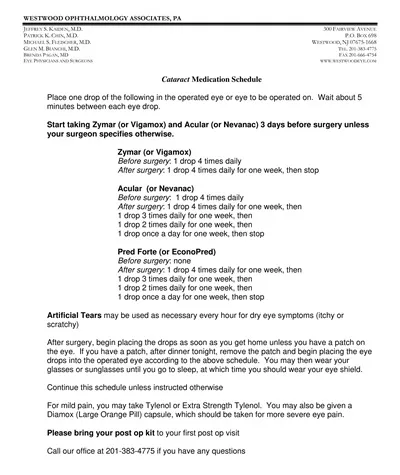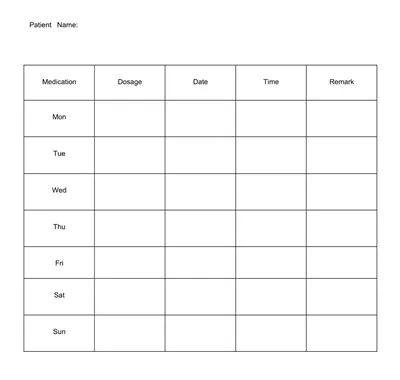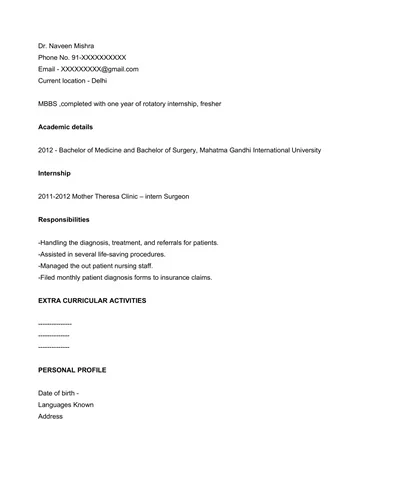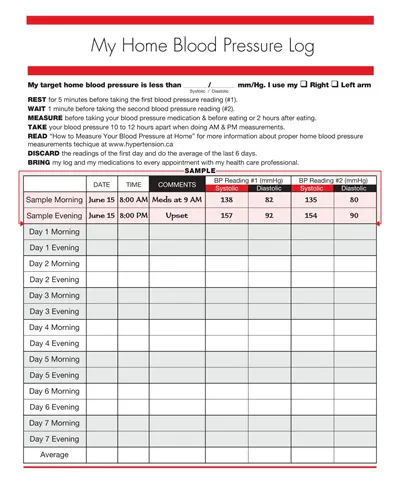A Medication Chart Template is a format utilized to help chart a patient’s medication schedule in medical facilities. It often contains information such as the name of every drug, dosage, times to take the medications, and course length.
Healthcare providers can use this template to guarantee the appropriate flow of medications, ensure patient compliance, and minimize errors. Recording all prescribed and administered drugs carefully and unambiguously, the chart helps other healthcare professionals manage patients’ health and drugs, contributing to patient safety.
Download Free Printable Medication Chart Templates
What is a Medication Chart?
A Medication Chart is a document used in medical facilities to highlight the type of medication that a specific patient is supposed to take. It is a complete patient chart of all prescribed medications, including important details such as dosage rate, how often, and when the medication should be available to the patient.
This chart is vital in medical institutions because it improves the precision of administration of medications, guarantees uniformity of care, and reduces medical mistakes. Also, the Medication Chart is, by definition, an interpersonal communication tool of clarifying purpose with easy and holistic understanding for all conventional healthcare practitioners treating a specific patient with patient safety and medical compliance objectives in mind.
Key Features of Medication Chart
A Medication Chart is implemented with unique characteristics that make it even more functional and useful in healthcare sectors. These features include:
- Detailed Medication Information: Each medication is indicated by its name, along with its docile form, strength, and route of administration, which makes the treatment scheme quite clear and accurate.
- Scheduled Administration Times: The chart clearly dispels the times within the day that each medication should be taken, thus ensuring that the patient stays strictly bound to the schedule.
- Start and Stop Dates: These show the period within which a medicine is supposed to be taken. This provides timelines that avoid overusing the drugs and help doctors review the patient’s progress.
- Space for Patient Information: This contains patient information such as his or her name, identification number, and any document to ensure the patient receives individual and safe treatment.
- Areas for Signatures: Incidental structures are included where the healthcare providers can sign after administering the medications to ensure an audit trail.
- Notes Section: An area whereby doctors and other health care practitioners can make other comments to facilitate constant patient evaluation and changes in management.
In conclusion, the features make the Medication Chart valuable when aiming to control and coordinate medication and create a safer environment for all patients.
Benefits of Medication Chart
Using a Medication Chart is not resistant to receiving a range of mandatory advantages to enhance the health care processes. Firstly, it improves medication administration by presenting an easily understandable patient’s medications list that healthcare givers can easily understand to ensure correct treatment administration.
A major advantage of this structure is the minimization of likely medication errors such as wrong or no dose. Moreover, a Medication Chart has been established, which helps to integrate the actual health care attendants team as the document is accessible to all the caregiving staff. They are all required to write their notes, making the process easy and more coordinated during shift transitioning.
Moreover, it is also helpful in monitoring the patients ‘compliance with medication because the patients and/or their caregivers can quickly note the medication schedule. Finally, according to the chart, important medication administration records are thoroughly documented, hence providing a sound legal and professional basis to ward off legal and professional repercussions that follow the violation of medical practice laws in health facilities. Each of them put together plays a great role in improving the efficacy of treatment and the safety of patients in treatment facilities.
Types of Medication Charts
Medication Charts are, therefore, very useful documents that can, however, be tailored to fit other healthcare uses and environments if needed. Several types of Medication Charts are commonly used, each designed to address specific requirements in patient care:
Inpatient Medication Chart
Similar to other countries, this chart is especially implemented in hospitals and depicts all medicines given to a patient while admitted. It includes data about regular prescriptions and prescriptions that allow objective documentation and enhance communication among hospital representatives.
Outpatient Medication Chart
This chart is for use by outpatients who have been treated by physicians in a facility other than a hospital. It is useful when patients are on fixed medication regimes or ever require long-term medication, hence being helpful when the patient is transferred from one environment to another.
Electronic medication administration record (eMAR)
The eMAR is a computerized form of the traditional medication chart used to increase access and decrease medication errors easily. It connects to other EHRs, and thus, it can provide summaries and alerts in real-time, making work easier when administering medications.
Pediatric Medication Chart
This chart is designed for children’s dosages and has special sections for extra notes on pediatric scaling based on age, weight, and development.
Geriatric Medication Chart
It targets elderly patients; it encourages the safe use of medicines since older adults are usually on multiple medications and are prone to experiencing drug interactions.
All Medication Charts are very important in achieving safe and effective client outcomes with individualized care. Depending on the category of healthcare and patient population, choosing the right chart improves medication management and accuracy.
Strategies for Utilization of Medication Charts
Optimization of Medication Charts can greatly improve the care services for hospitalized patients. Here are some essential tips for using these tools:
- Ensure Completeness: It is recommended that the Medication Chart be filled out as thoroughly as possible regarding the patient’s details, medication details, and time of administration. Lack of awareness of this or that detail could result in mistakes when it comes to medication.
- Update Information Regularly: Patients may be on a certain medication dose while their condition, such as chronic illness, can change over time. The Medication Chart format can be completed by adding new prescriptions, changes in dosage, and other discontinued medications.
- Check for Accuracy: Every time you are about to administer any drug, cross-check the chart and compare it with the patient’s prescription order. When details match, the risk of medication errors can be greatly diminished.
- Use Clear and Legible Writing: If a paper chart is employed, ensure the officer’s handwriting is profound so that the true information is not ambiguous. Otherwise, switch over to handling electronic charts to make them easier to read.
- Communicate with the Healthcare Team: The chart should then be used to inform other people in the healthcare team and exchange updated information. This ensures an ideal flow of care and follow-up for the patient since there is only one qualified physician they deal with.
- Educate Patients and Caregivers: Be sure to spend time reviewing with the patient and/or caregivers how to read the chart. Knowledge about the chart, reading, and interpreting help patients stick to their medication schedule and master their treatment.
- Review and Audit Regularly: It’s important to review and audit the medication chart from time to time to ensure that it is accurate to the best of health care standards. This process can also reveal practices in medication management that need to be changed.
With these tips in place, Medication Charts will achieve their optimal purpose of increasing the accuracy and safety of medication administration and, thus, patients’ outcomes.
Importance of Medication Management
Medication management is well recognized as a core aspect of healthcare interventions, where medication optimization contributes to delivering expected patient care and avoiding untoward outcomes.
Through appropriate administration, the patient receives the correct medication strength, which minimizes the adverse effects of taking the wrong dosage or the wrong type of drug. It also aids with compliance to recommended treatment regimens, which is crucial in the care of chronic conditions and in stopping further deterioration of diseases.
By using systematic plans like Medication Charts, healthcare providers can also improve interprofessional relationships because they are better organized and accurately order affairs. On the same note, they help organize medication communication amongst the various healthcare teams, creating teamwork to achieve patient-sanctioned medication safety goals.
The need for sound medication management practices has never been greater within the multifaceted environment of modern healthcare systems for the purpose of enhancing outcomes and quality-of-life-for-patients benefits.
How to Create a Medication Chart Template
When designing a Medication Chart Template, the following aspects are considered to arrive at optimal Fulfilling of Medication Management: Follow these steps to design a practical and user-friendly template:
- Determine the Purpose and Scope: Determine the goals of the medication chart for inpatient care, outpatient care, or pediatric and/or geriatric care. Now, define the scope to adequately meet these needs.
- Include Essential Sections: The crucial elements of the template should be the patient’s details (name, age, MR#, medication name, dose, frequency of administration, route of administration, and start/end dates of the drug administration).
- Design for Clarity and Readability: Employ section titles and boundaries while presenting dissimilar kinds of data. The layout should also allow easy identification of all the important information and reduce the error margin as much as possible.
- Incorporate Checkboxes or Fields for Administration Times: Include other numerical/ check box-filled areas where the providers can tick at each dose given to the patients to ensure compliance with the doses ordered and as a way to track the same.
- Add Areas for Special Instructions and Notes: It is also vital to have space designated for extra information regarding the medicine’s usage (for example, the necessity to take it with meals ) or notes that might be quite useful for individual cases and protection of the patient against adverse effects of the medicine.
- Ensure Flexibility: The template should be simpler and flexible enough to fit any medication and dosage forms, as they vary between pills, injections, etc.
- Facilitate Electronic Integration: Before creating a template, check whether it will be compatible with the EHR systems regarding integration and improved database processes.
- Review and Test the Template: Healthcare professionals should conduct a review before implementing the template into broader use; the template should also be piloted to reveal necessary adjustments in a controlled environment.
If the above guidelines and your healthcare environment characteristics are taken into consideration, the Medication Chart Template can improve efficiency, reduce error rate, and improve medication safety for patients.

